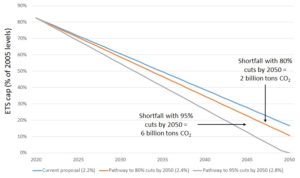On Monday 20 June, the EU environment ministers will discuss whether the proposed revisions of the EU’s carbon market are enough to bring the bloc’s flagship climate instrument in line with the Paris climate change agreement. In this article, Carbon Market Watch answers key questions to help ministers come up with an appropriate response.
Do the proposed revisions bring the EU ETS in line with keeping global temperatures to well below 2°C warming?

No.
The proposed 2.2% annual reductions of the EU ETS emissions are not in line with the 2°C objective, let alone 1.5°C.
In fact, even the European Commission has admitted that as it stands, the revision does not bring the EU ETS on track towards the EU’s long-term climate goals. Instead, the EU will produce at least 2 billion tonnes more CO2 than its Paris climate pledge.
The Commission has stated that the EU ETS emissions need to be cut by 2.4% each year to reach EU-wide cuts of 80%, the lowest end of the EU’s 2050 objective.
In order to achieve the higher end of the 2050 climate objective, emission reductions of 95%, they should be cut by at least 2.8% each year.
Even steeper reductions are required to limit global warming to below 1.5°C.

Do the proposed revisions bring the EU ETS in line with the polluters pay principle?
No.
Researchers estimate that in order to reach the Paris Agreement’s climate objectives, the carbon price should be over 40 euros per tonne. But the price is 6 euros at the moment, and predicted to only slowly rise to an average of 14 euros in the next decade up to 2030. This is too little to drive decarbonisation.
Additionally, companies responsible for almost half of the emissions covered by the EU ETS do not have to pay a single cent for their pollution. Instead, industries were so far able to profit from their carbon emissions. They were handed more permits for free than they actually needed, and were able to sell the remaining permits for a profit on the market. A recent study has shown that heavy polluters made over 24 billion euros from the EU ETS between 2008 and 2014.
Under the current revision, industry will continue to profit from these free hand-outs instead of having to pay for their pollution. The Commission’s own analysis shows that industries could make over €19 billion profits in the 2021-2030 period by letting their customers pay for a non-existent carbon cost.

[Source: European Commission, SWD (2015) 135, p. 183 table 24]
Do the proposed revisions reduce industry’s climate impact?
No.
Even though deep emission cuts are possible in industry, they will not happen under the current EU ETS rules. Without a change of the rules, industry’s emission cuts will stall over the next 15 years according the European Environment Agency.
This is not in line with the Paris Agreement’s objective. Fortunately, a new study shows that Europe’s energy intensive industries can still significantly reduce their emissions while maintaining or enhancing their competitiveness.
So how can the EU ETS become future-proof?
The EU ETS needs to be drastically reformed for it to become a truly future-proof climate instrument:
- Steeper emission cuts than the proposed 2.2% are required for the EU ETS to be in line with the EU’s long-term climate objectives.
- The next trading period of the EU ETS must start at actual emission levels to avoid a further build-up of surplus, rather than starting from the inadequate 2020 targets.
- Surplus pollution permits from the current trading period must not be given away to new entrant big polluters as this would undermine the EU’s 2030 climate commitment.
- The ‘hot air’ of surplus allowances that will be stored in the Market Stability Reserve should not be valid for use after 2020.
- The free hand outs to industry need to be phased out by gradually increasing the share of allowances to be auctioned from the current level of 57%.
- Industries that are not at risk of carbon leakage should not receive any free pollution permits.
- There needs to be an incentive for industry to innovate by annually reducing the amount of free pollution permits that an installation receives (the benchmark).
Femke De Jong






